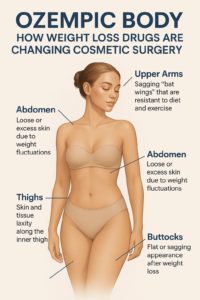In recent years, weight loss medications like Ozempic, Wegovy, and Mounjaro have transformed the conversation around weight management. Originally developed to treat type 2 diabetes, these injectable medications—known as GLP-1 receptor agonists—have become widely known for their ability to support rapid and sustained weight loss.
But the effects of these medications go beyond the number on the scale. As more patients experience significant body transformations, a new trend has emerged in cosmetic surgery: the “Ozempic body.”
From skin laxity to body proportions, this medication-driven weight loss is reshaping not just bodies—but also the cosmetic procedures patients are now seeking. In this blog, we’ll dive into what the “Ozempic body” really means, and how it’s changing the landscape of plastic surgery.
What Is an “Ozempic Body”?
The term Ozempic body refers to the physical appearance that often results from rapid, medication-assisted weight loss. While the results can be dramatic and transformative, they also come with new aesthetic challenges—including loose skin, volume loss in the face, and changes in body contour.
Some common characteristics of the Ozempic body include:
- Deflated or sagging skin around the arms, abdomen, and thighs
- Hollowed cheeks or “Ozempic face”
- More pronounced cellulite or skin irregularities
- A desire to refine and rebalance proportions after major weight loss
For many, the transformation brings an incredible sense of pride—but also a desire to refine their results through cosmetic procedures.

How Weight Loss Drugs Work
GLP-1 medications like Ozempic mimic a hormone that helps regulate blood sugar levels, reduce appetite, and slow gastric emptying. The result? Patients feel full faster and eat less overall, often resulting in significant weight loss over a short period.
On average, patients lose between 15% to 20% of their total body weight within 6 to 12 months. While this is a major win for health and self-esteem, it’s also where plastic surgery begins to play a supporting role.
Cosmetic Challenges After GLP-1 Weight Loss
Rapid weight loss, regardless of the method, can leave behind several cosmetic concerns. Here are the most common ones plastic surgeons are seeing in post-GLP-1patients:
1. Loose, Sagging Skin:
Skin elasticity can’t always keep up with the pace of weight loss. The faster the body shrinks, the harder it is for the skin to retract. Many GLP-1 users report loose skin on the abdomen, arms, thighs, and breasts.
2. Facial Volume Loss:
The face often shows the earliest signs of weight loss. For some, this means sharper cheekbones and a more sculpted jawline. For others, it results in a hollow, tired appearance—commonly referred to as “Ozempic face.”
3. Imbalance in Proportions:
After losing a significant amount of fat, patients may feel that their body shape no longer matches their frame. This leads to a demand for body contouring procedures that restore balance and definition.
Cosmetic Procedures Trending Post-GLP-1
To address the after-effects of rapid weight loss, patients are turning to a range of plastic surgery and non-surgical treatments. These procedures focus on tightening skin, restoring volume, and refining body contours.
1. Skin Tightening Procedures
- Tummy Tuck (Abdominoplasty): Removes loose, sagging skin and tightens abdominal muscles for a firmer, flatter stomach.
- Arm Lift (Brachioplasty): Eliminates “bat wings” or hanging skin from the upper arms.
- Thigh Lift: Tightens and contours the inner and outer thighs.
- Lower Body Lift: A comprehensive solution for patients with skin laxity around the hips, buttocks, and thighs.
2. Facial Rejuvenation
- Fat Transfer: Uses your own fat to restore volume in the cheeks, under-eyes, and temples.
- Dermal Fillers: A non-surgical option to plump and refresh hollow areas of the face.
- Facelift or Neck Lift: Repositions sagging skin and muscles for a smoother, more youthful appearance.
3. Body Contouring
- High Definition Liposuction: Refines areas that still hold onto fat or need sculpting.
- Gluteal Enhancement: Adds volume to the buttocks using fat grafting or implants to restore curves lost during weight loss.
- Breast Lift or Augmentation: Lifts deflated breasts or restores fullness with implants or fat transfer.
Is Surgery Always Needed After GLP-1?
Not necessarily. Some patients experience minimal sagging or are satisfied with the natural results. Others may use non-surgical treatments like skin-tightening lasers or radiofrequency devices to enhance their results without surgery.
Ultimately, the decision depends on your goals, the quality of your skin, and how much weight you’ve lost. A consultation with a board-certified plastic surgeon can help you understand your options and design a plan tailored to your body.
How This Is Shaping the Future of Cosmetic Surgery
The rise of GLP-1 medications is reshaping not just bodies—but also the plastic surgery industry. Surgeons are seeing a shift in the types of procedures requested, and they’re adapting their techniques to address the unique concerns of post-weight-loss patients.
Key trends include:
- More combination surgeries: Patients are opting for body lifts with fat transfer or facelifts with volume restoration.
- Earlier consultations: Patients are scheduling surgery consultations before reaching their goal weight to plan ahead.
- More customized planning: Treatment is becoming more personalized, with a focus on long-term aesthetics and structural harmony.
The GLP-1 era is changing the way people lose weight—and the way they approach cosmetic surgery. For many, these medications are life-changing tools that spark a journey toward better health and body confidence.
But as the pounds come off, it’s natural to want your appearance to reflect the work you’ve done. That’s where cosmetic surgery comes in—helping to refine, restore, and enhance your new shape in a way that feels empowering and lasting.
If you’re on a weight loss journey with GLP-1 or a similar medication and wondering what’s next, a cosmetic consultation can help you explore your options and create a plan that aligns with your goals.



Comments are closed here.